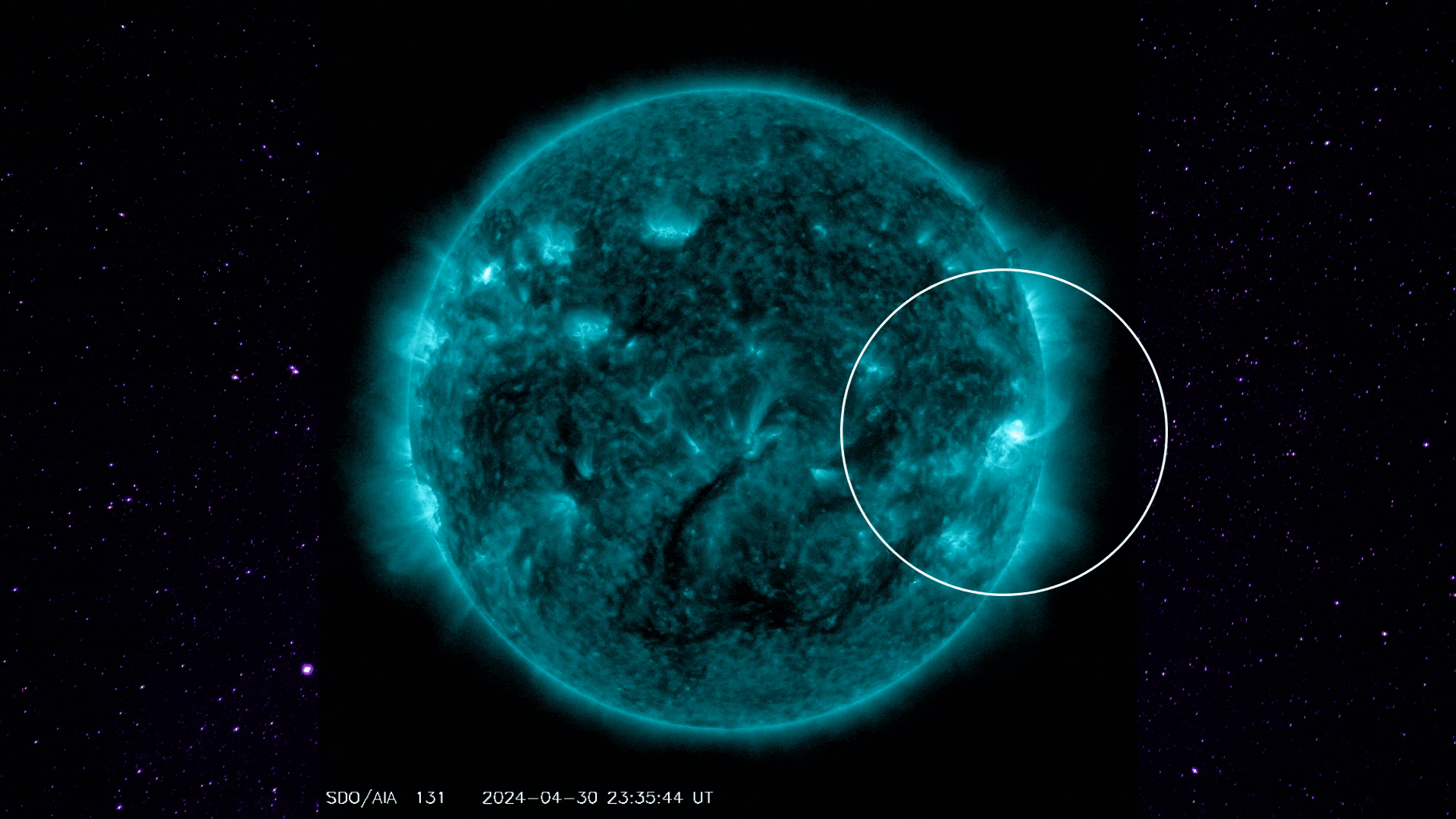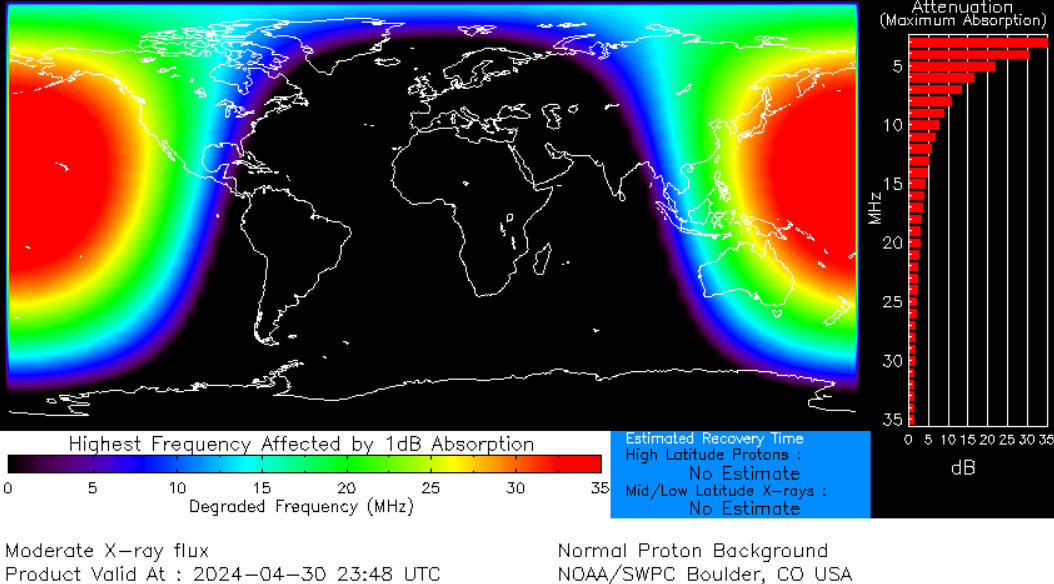Sun unleashes near X-class solar flare: M9.5 eruption sparks radio blackouts across the Pacific (video)
The solar flare is the most powerful eruption from sunspot region R3654 yet.
Last night (April 30), the sun released an extremely powerful solar flare triggering widespread radio blackouts across the Pacific region. The flare peaked at 7:46 p.m. EDT (2346 GMT) and ended shortly after at 7:58 p.m. EDT (2358).
Solar flares are eruptions from the sun's surface that emit intense bursts of electromagnetic radiation. They are created when magnetic energy builds up in the solar atmosphere and is released. Solar flares are categorized by size into lettered groups, with X-class being the most powerful. Then there are M-class flares that are 10 times less powerful than X-class flares, followed by C-class flares which are 10 times weaker than M-class flares, B-class are 10 times weaker than C-class flares and finally, A-class flares which are 10 times weaker than B-class flares and have no noticeable consequences on Earth.
Within each class, numbers from 1-10 (and beyond for X-class flares) describe a flare's relative strength. The recent April 30 flare clocked in at M9.53, according to Spaceweatherlive.com, measured by NASA's GOES-16 satellite, which puts it just a fraction below an X-class solar flare.
Related: Watch 4 solar flares erupt from the sun at nearly the same time in extremely rare event (video)
Shortwave radio blackouts like the one witnessed over the Pacific are common shortly after powerful solar flare eruptions due to the strong pulse of X-rays and extreme ultraviolet radiation emitted during the event. The radiation travels toward Earth at the speed of light and ionizes the top of Earth's atmosphere when it reaches us.

This ionization causes a higher-density environment that the high-frequency shortwave radio signals must attempt to navigate through to support communication over long distances. The radio waves that interact with electrons in the ionized layers lose energy due to more frequent collisions, and this can lead to radio signals becoming degraded or completely absorbed according to the National Oceanic and Atmospheric Administration (NOAA) Space Weather Prediction Center.
Radiation from the April 30 solar flare affected those on the sunlit portion of Earth at the time of the eruption, the Pacific regions. "Mariners and ham radio operators may have noticed loss of signal below 20 MHz for as much as 30 minutes after the flare's peak," according to Spaceweather.com.
Get the Space.com Newsletter
Breaking space news, the latest updates on rocket launches, skywatching events and more!

Solar activity is ramping up as we approach solar maximum, the peak of solar activity during the sun's approximately 11-year solar cycle, indicated by the frequency of sunspots.
Despite the large number of sunspots currently visible on the sun's surface, our star has been relatively quiet in recent weeks. But not anymore.
The near X-class solar flare erupted from the sunspot region AR3654, the most powerful eruption from this region yet.
"It is always exciting when a sunspot region lives up to its potential. AR3654 has just done that." solar scientist Alex Young posted on X.
😱Update Apr 30, 2024: Almost X flare!👏💥🤩It is always exciting when a sunspot region lives up to its potential. AR3654 has just done that. At 23:23 UTC on Apr 30, the region released a flare that almost made it to X with an M9.5. 🧐MORE at EarthSky: https://t.co/xD29wLfm4e pic.twitter.com/efGC1G2Rn8May 1, 2024
"Despite high sunspot numbers for the last couple of weeks, tonight's near X-class #SolarFlare is the first decent-sized flare in some time! When and where will the next X-class event come from?" solar astrophysicist Ryan French posted on X.
Despite high sunspot numbers for the last couple of weeks, tonight's near X-class #SolarFlare is the first decent-sized flare in some time! When and where will the next X-class event come from? #spaceweather pic.twitter.com/Thbrjy2XMyMay 1, 2024
Solar scientists are keeping a watchful eye on the sun as it approaches solar maximum because solar activity can impact our lives on Earth.
Powerful flares can significantly affect spacecraft, satellites and ground-based technologies, traveling at the speed of light, and they don't give a lot of notice before striking. That's why numerous organizations — including NASA, NOAA and the U.S. Air Force Weather Agency (AFWA) — are monitoring the sun closely. These organizations can send out warnings to technology and infrastructure sectors vulnerable to solar flare activity so that appropriate precautions can be taken in the event of potentially harmful space weather.
"We can't ignore space weather, but we can take appropriate measures to protect ourselves," NASA says.
But there is no need to worry; so-called "killer flares" do not exist and although solar flares have the potential to significantly disrupt the technological world, they don't contain enough energy to do any lasting damage to Earth itself.
"Even at their worst, the sun's flares are not physically capable of destroying Earth," NASA says.
Join our Space Forums to keep talking space on the latest missions, night sky and more! And if you have a news tip, correction or comment, let us know at: community@space.com.

Daisy Dobrijevic joined Space.com in February 2022 having previously worked for our sister publication All About Space magazine as a staff writer. Before joining us, Daisy completed an editorial internship with the BBC Sky at Night Magazine and worked at the National Space Centre in Leicester, U.K., where she enjoyed communicating space science to the public. In 2021, Daisy completed a PhD in plant physiology and also holds a Master's in Environmental Science, she is currently based in Nottingham, U.K. Daisy is passionate about all things space, with a penchant for solar activity and space weather. She has a strong interest in astrotourism and loves nothing more than a good northern lights chase!









